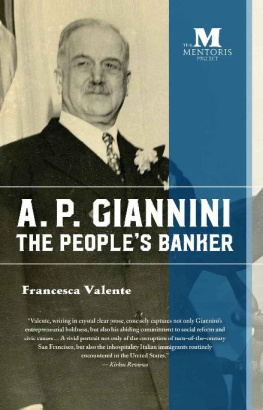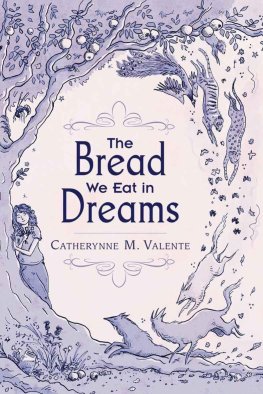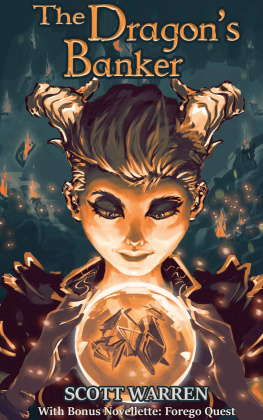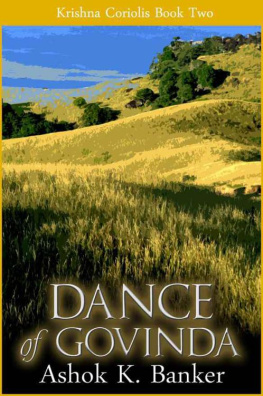Valente - A.P. Giannini: the peoples banker
Here you can read online Valente - A.P. Giannini: the peoples banker full text of the book (entire story) in english for free. Download pdf and epub, get meaning, cover and reviews about this ebook. year: 2017, publisher: Barbera Foundation, Inc., genre: Detective and thriller. Description of the work, (preface) as well as reviews are available. Best literature library LitArk.com created for fans of good reading and offers a wide selection of genres:
Romance novel
Science fiction
Adventure
Detective
Science
History
Home and family
Prose
Art
Politics
Computer
Non-fiction
Religion
Business
Children
Humor
Choose a favorite category and find really read worthwhile books. Enjoy immersion in the world of imagination, feel the emotions of the characters or learn something new for yourself, make an fascinating discovery.
- Book:A.P. Giannini: the peoples banker
- Author:
- Publisher:Barbera Foundation, Inc.
- Genre:
- Year:2017
- Rating:4 / 5
- Favourites:Add to favourites
- Your mark:
- 80
- 1
- 2
- 3
- 4
- 5
A.P. Giannini: the peoples banker: summary, description and annotation
We offer to read an annotation, description, summary or preface (depends on what the author of the book "A.P. Giannini: the peoples banker" wrote himself). If you haven't found the necessary information about the book — write in the comments, we will try to find it.
Valente: author's other books
Who wrote A.P. Giannini: the peoples banker? Find out the surname, the name of the author of the book and a list of all author's works by series.
A.P. Giannini: the peoples banker — read online for free the complete book (whole text) full work
Below is the text of the book, divided by pages. System saving the place of the last page read, allows you to conveniently read the book "A.P. Giannini: the peoples banker" online for free, without having to search again every time where you left off. Put a bookmark, and you can go to the page where you finished reading at any time.
Font size:
Interval:
Bookmark:


First and foremost, Mentor was a person. We tend to think of the word mentor as a noun (a mentor) or a verb (to mentor), but there is a very human dimension embedded in the term. Mentor appears in Homers Odyssey as the old friend entrusted to care for Odysseuss household and his son Telemachus during the Trojan War. When years pass and Telemachus sets out to search for his missing father, the goddess Athena assumes the form of Mentor to accompany him. The human being welcomes a human form for counsel. From its very origins, becoming a mentor is a transcendent act; it carries with it something of the holy.
The Barbera Foundations Mentoris Project sets out on an Athena-like mission: We hope the books that form this series will be an inspiration to all those who are seekers, to those of the twenty-first century who are on their own odysseys, trying to find enduring principles that will guide them to a spiritual home. The stories that comprise the series are all deeply human. These books dramatize the lives of great Italians and Italian-Americans whose stories bridge the ancient and the modern, taking many forms, just as Athena did, but always holding up a light for those living today.
Whether in novel form or traditional biography, these books plumb the individual characters of our heroes journeys. The power of storytelling has always been to envelop the reader in a vivid and continuous dream, and to forge a link with the subject. Our goal is for that link to guide the reader home with a new inspiration.
What is a mentor? A guide, a moral compass, an inspiration. A friend who points you toward true north. We hope that the Mentoris Project will become that friend, and it will help us all transcend our daily lives with something that can only be called holy.
Robert J. Barbera, President, Barbera Foundation
Ken LaZebnik, Editor, The Mentoris Project
T he unique success story of Amadeo Pietro Gianninis progress from enlightened self-taught man to one of the most powerful and far-sighted bankers of the twentieth century runs parallel to the transformation of his home state California from a promising but peripheral state to the leading region of the western United States, providing a fertile ground for the fulfillment of the American Dream. The seeds of his vocation and mission are traceable to his challenging childhood, which molded him into a revolutionary in the banking world.
His father, Luigi Giannini, was an immigrant of humble origins from Liguria who was lured to California by the exciting prospects of the Gold Rush, deciding in 1864 to set out from his native village of Favale di Malvaro in the Val Fontanabuona, thirty miles northeast of Genoa.
People coming to the United States in search of better lives often banded together with their own kind for some time before assimilating into the melting pot of American culture. Luigi was part of the first, most intense phase of migration to the West Coast, which took place during the middle of the nineteenth century and immediately after the unification of Italy in 1861. Although Giuseppe Garibaldi, the great hero of the Italian Risorgimento, had succeeded in uniting the northern and southern parts of the peninsula, life in Italy continued to be very harsh. Unification in fact began with a heavy tax burden imposed by Rome, especially on farmers. As Deanna Paoli Gumina has pointed out in her book Italians of San Francisco: 18501930, the migratory wave to the western United States was very different from the one in which Italians settled on the Atlantic coast.1 In New York, newly arrived Italians appeared to be destined, at least initially, to a condition of social inferiority whereas the westbound immigrants possessed unique professional skills and were relatively more affluent, which enabled them to bear the additional expense of crossing the continent and the physical hardships associated with resettlement; most of them became successful in a brief period of time in fishing, farming, and viniculture in the Sonoma and Napa Valleys.
When Luigi returned to California for the second time in 1868, he knew he was through searching for gold. He still wanted to settle in California and raise a family in that fertile land. He already had a girl in mind named Virginia De Martini but he had never met her in person. Luigi got to know her through the frequent letters she sent to her two brothers while he was working with them in the gold fields. While they read her intriguing correspondence around the campfire, Luigi felt a secret attraction and somehow knew she was the right person for him. He went back to Italy just to meet her, which turned out very successfully. He managed to convince her parents he was a worthy suitor: to impress them, he wore a double money belt with a supply of $20 gold pieces. After an intense six-week courtship, he married Virginia on August 10, 1869, shortly after her fifteenth birthday, in Chiavari, on the Ligurian coast. At the wedding she wore a white hat that he had brought her as a gift from America and it became the talk of the town, as Virginias elder sister Teresa later recounted to A.P Giannini himself.2
They set off in 1869 for the United States, crossing the Atlantic on a third-class ticket. After docking in New York they were able to cross the country by train since the Transcontinental Railroad had just been completed, thus avoiding the treacherous route across the Isthmus of Panama with its jungle and suffocating heat. By the fall they were settled in San Jose, a frontier town in the Santa Clara valley, about fifty miles from San Francisco, and older than any other settlement in California. Luigi invested all his savings in renting and renovating a house, which he turned into the Swiss Hotel, a two-story building with twenty rooms, which catered to Italian day-laborers belonging to the steady European migration in search of riches. Many were attracted by the warm atmosphere created by the two Italian-American immigrants in a country where, notwithstanding the genuine opportunities for hard-working people, foreigners in generaland especially those of Chinese and Italian originwere often disliked, mistrusted, looked upon with suspicion and hostility, and frequently faced open discrimination. They had to prove themselves in order to overcome all the prejudices against them.
It was in the Swiss Hotel that on May 6, 1870 the Gianninis first son was born and christened Amadeo Pietro. After two years as the owner of the hotel, Luigi successfully sold it and with the proceeds bought forty acres of land in the small town of Alviso, eight miles north of San Jose. The Giannini farm prospered between 1871 and 1876 because of its excellent location and climate, which their motivation and hard work exploited to the fullest. They were learning English while acquiring their American citizenship. Across the state their fellow Italians were settling a number of farmlands and were to play a leading role in developing todays fruit, vegetable, and dairy industries, while also leaving their mark on the California food-processing industry.
Luigi and Virginia had all the elements for establishing themselves as an ever more solid family unit and as successful farmers. Their second son, Attilio, was born in July 1874, while Amadeo, still a toddler, loved playing outdoors and was always eager to help his parents with picking strawberries and fruit from the trees in that natural hothouse. He soon enrolled in the elementary school and enjoyed studying with children of many nationalities (Portuguese, Italian, French, German, Spanish, Armenian, Japanese, and American) who were sometimes unable to pronounce his Italian name. He had a good time, learning quickly from books and making lifelong friends. This was the environment that saw Luigi become an independent, successful farmer bringing his wagons filled with produce to Alviso, which rapidly turned from a small, sleepy town into a hub for the nationwide distribution of local produce. By 1875, the Pacific Fruit Express would carry the fruit and vegetables of the Santa Clara Valley in refrigerated carriages to the rest of the nation. Luigi became a prominent figure among the thousands of transplanted farmers who swarmed into San Jose in the decades after the Gold Rush, and was able to provide a comfortable life for his wife and children. He was proud to follow in the footsteps of his father Carlo, his grandfather Stefano, and his great-grandfather Giuseppe, who for generations had farmed the land back in their native Favale.
Font size:
Interval:
Bookmark:
Similar books «A.P. Giannini: the peoples banker»
Look at similar books to A.P. Giannini: the peoples banker. We have selected literature similar in name and meaning in the hope of providing readers with more options to find new, interesting, not yet read works.
Discussion, reviews of the book A.P. Giannini: the peoples banker and just readers' own opinions. Leave your comments, write what you think about the work, its meaning or the main characters. Specify what exactly you liked and what you didn't like, and why you think so.













